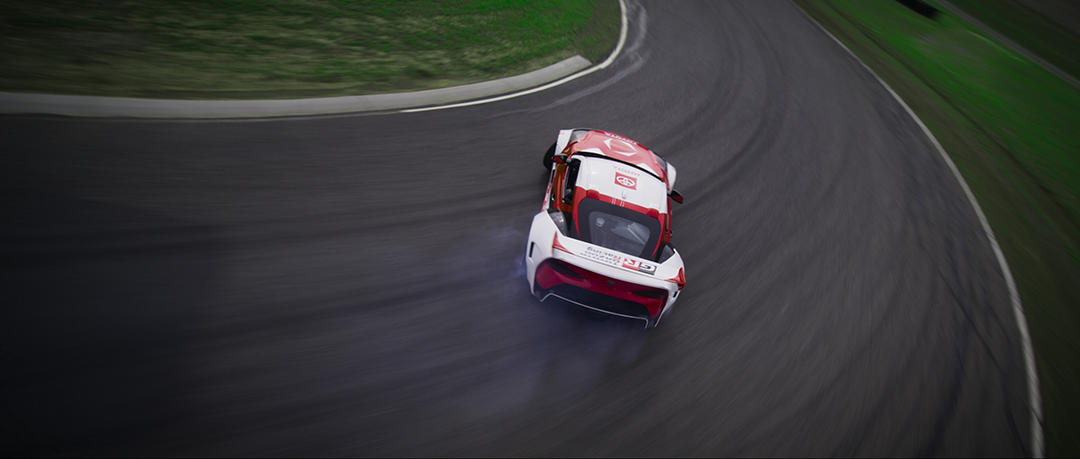LANGUAGES

Test Car Drifts Autonomously on a Closed Course
LOS ALTOS, Calif. (Feb. 2, 2022) — Today, Toyota Research Institute (TRI) demonstrated a new research milestone in autonomy, providing a glimpse into the future of safer mobility for all.
As revealed in this video, TRI researchers successfully programmed a vehicle to autonomously drift around obstacles on a closed track — a world first. Combining a deep knowledge of both vehicle dynamics and control design, TRI’s Nonlinear Model Predictive Control (NMPC) approach extends the vehicle’s operational domain to the very limits of its performance. The idea behind this research is to utilize controlled, autonomous drifting to avoid accidents by navigating sudden obstacles or hazardous road conditions like black ice.
“At TRI, our goal is to use advanced technologies that augment and amplify humans, not replace them,” said Avinash Balachandran, senior manager of TRI’s Human Centric Driving Research. “Through this project, we are expanding the region in which a car is controllable, with the goal of giving regular drivers the instinctual reflexes of a professional race car driver to be able to handle the most challenging emergencies and keep people safer on the road.”
Every year, car crashes result in nearly 40,000 fatalities in the United States and about 1.35 million fatalities worldwide. While most crashes occur in mundane situations, in some extreme situations, drivers may need to make maneuvers that take their vehicle close to and, at times, beyond normal limits of handling.
One year ago, TRI and the Dynamic Design Lab at Stanford University set out to design a new level of active safety to help avoid crashes and prevent injuries and fatalities. With the support of automotive performance specialist GReddy and drift legend Ken Gushi, today’s achievement is another step in that journey. By building skills comparable to an expert driver, this technology can amplify and augment a regular driver’s ability to respond to dangerous and extreme situations, helping keep people safe on the road.
“When faced with wet or slippery roads, professional drivers may choose to ‘drift’ the car through a turn, but most of us are not professional drivers,” said Jonathan Goh, TRI research scientist. “That’s why TRI is programming vehicles that can identify obstacles and autonomously drift around obstacles on a closed track.”
This achievement brings TRI researchers closer to understanding the full spectrum of vehicle performance. The software advances announced today calculate a whole new trajectory every 20th of a second to balance the car gracefully as it goes around the track.
Looking ahead, Toyota will continue to push the limits of vehicle safety technology by researching ever more effective ways for emerging safety technologies to amplify human capabilities on the road.
Technical Details
- This technology uses Nonlinear Model Predictive Control (NMPC).
- Combining the vehicle dynamics and control design insights from drifting-specific approaches with the generalized framework of NMPC yields a control scheme that extends the vehicle’s operational domain beyond the point of tire saturation. This allows the vehicle to drive beyond the notions of traditional open loop stability to where the vehicle is skidding but still controllable due to closed loop driving control.
- Recently, Toyota Research Institute has developed a step toward such a unified approach and experimentally demonstrated an NMPC controller that can smoothly transition from dynamic, non-equilibrium drifting to grip driving, while accounting for multiple objectives including road bounds.
- This approach was tested on a Toyota Supra that has been specially customized for autonomous driving research. It is equipped with computer-controlled steering, throttle, clutch displacement, sequential transmission and individual wheel braking. Vehicle state information is obtained from a dual-antenna RTK-GNSS-aided INS system at a rate of 250Hz, and the NMPC controller runs on an x86 computer.
- For the purposes of data collection with expert drivers in a controlled environment, the suspension, engine, transmission, chassis and safety systems (e.g., roll cage, fire suppression) have been modified to be similar to that used in Formula Drift
- Experiments were conducted at Thunderhill Raceway, on the 2-mile ‘West’ track.
About Toyota Research Institute
Toyota Research Institute (TRI) conducts research to advance robotics, energy and materials, machine learning, and human-centric artificial intelligence. Led by Dr. Gill Pratt, TRI’s team of researchers are developing technologies to amplify human ability, focused on making our lives safer and more sustainable. Established in 2015, TRI has offices in Los Altos, California; Cambridge, Massachusetts; and Ann Arbor, Michigan. For more information about TRI, please visit http://tri.global.
Every effort has been made to ensure the product specifications, equipment, and content on this site are accurate based on information available at time of publishing. In some cases, certain changes in standard equipment or options may occur, which may not be reflected online. Toyota Canada reserves the rights to make these changes without notice or obligation.